Top 12 Dispatch Software Open Source Solutions in 2025
Efficient dispatching is the backbone of success for countless organizations, from emergency first responders to last-mile delivery services. Proprietary dispatch software often comes with steep licensing fees, vendor lock-in, and limited customization. This is where dispatch software open source solutions shine, offering unparalleled flexibility, control, and significant cost savings. This guide moves beyond generic feature lists to explore the top open-source platforms that can transform your operations.
We provide a detailed analysis of each option, focusing on practical, real-world examples and actionable insights. You will learn how self-hosting and customization can dramatically reduce your operational overhead, saving you money that would otherwise be spent on commercial licenses. For each platform, we include screenshots, direct links, and an honest assessment of its strengths and limitations to help you make an informed decision.
This curated list is designed to help you find the best solution for your specific needs, whether you manage a public safety agency, a logistics company, or a field service team. Prepare to discover how you can tailor a powerful dispatch system to your exact requirements without breaking the budget. Let's dive into the platforms that put you in control.
1. Resgrid, LLC
Resgrid positions itself as a premier choice in the dispatch software open source landscape, offering a remarkably comprehensive platform tailored for first responders, public safety agencies, and commercial operations. It’s an all-in-one system that integrates dispatching, personnel management, real-time tracking, and communication tools into a cohesive and user-friendly interface. This robust feature set empowers organizations to manage complex logistics and critical incidents with greater efficiency and clarity.
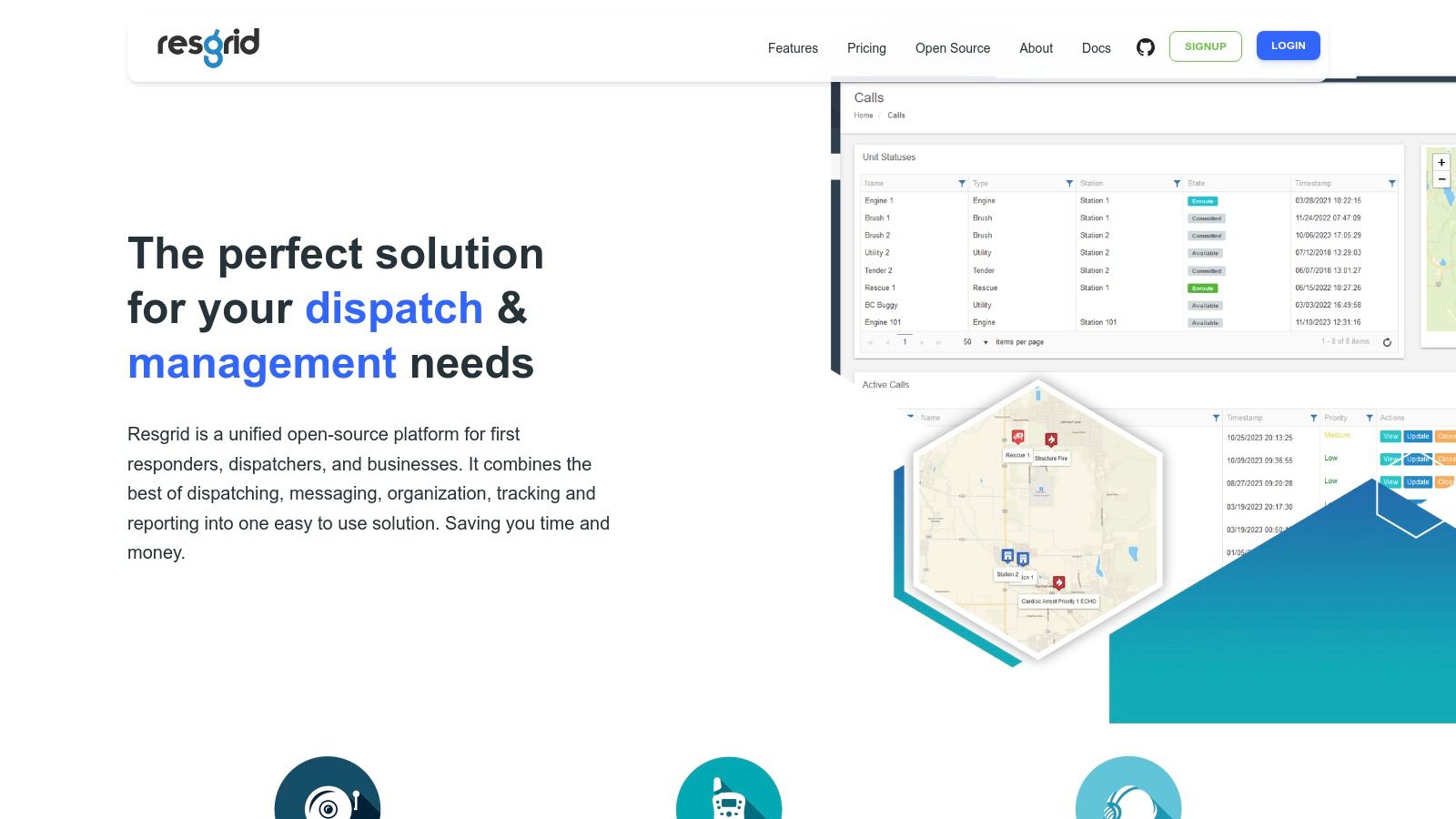
What truly distinguishes Resgrid is its dedication to both open-source principles and a self-service model. This combination provides unparalleled flexibility, allowing technically adept teams to customize the software to their exact specifications while offering an accessible, no-contract hosted solution for others. Its decade-long history of continuous development ensures a mature, stable platform that receives frequent feature updates at no extra cost to users. For organizations seeking to explore the platform's foundation, you can learn more about Resgrid's open-source dispatch framework.
Practical Use Cases and Cost-Saving Insights
The platform's design translates into tangible benefits and significant cost savings. For volunteer fire departments, Resgrid can replace multiple disjointed systems (like text message alerts, scheduling apps, and paper logs) with a single, unified solution. This consolidation not only streamlines operations but also eliminates the subscription fees from several different vendors.
A security company can use Resgrid’s real-time GPS tracking to optimize guard patrols, reducing fuel consumption and improving response times without investing in expensive, dedicated fleet management hardware. The self-service model is a major advantage, as it bypasses hefty implementation and consultant fees typically associated with enterprise-level dispatch software.
Key Features and Analysis
| Feature | Analysis & Practical Application |
|---|---|
| Unified Dispatch & CAD | Integrates call-taking, unit recommendations, and incident logging. Ideal for small to mid-sized dispatch centers needing a modern, affordable CAD system. |
| Personnel Management | Manages rosters, certifications, and availability. This feature is critical for volunteer agencies to quickly determine who is available to respond. |
| Real-Time GPS Tracking | Provides live location data for personnel and apparatus, enhancing situational awareness and ensuring safety during large-scale incidents. |
| Integrated Communication | Includes push notifications, group messaging, and real-time chat, ensuring reliable communication even when radio systems are congested. |
| Self-Service Model | No contracts or mandatory setup fees. Organizations can sign up and start using the system immediately, offering a low-risk, cost-effective entry point. |
Pros & Cons
- Pros: Comprehensive all-in-one platform, highly customizable open-source core, no contracts or setup fees, continuous free updates, strong real-time communication tools.
- Cons: Deep customization of the open-source version requires significant technical expertise. The hosted version's pricing tiers may require direct inquiry for precise budgeting.
Website: https://resgrid.com
2. Fleetbase
Fleetbase positions itself as a modern, modular, open-source logistics platform ideal for startups and businesses that prioritize developer control and data ownership. Unlike monolithic systems, it's built with an API-first approach, allowing for deep integration and custom workflow creation. This makes it a strong contender for companies needing a flexible dispatch software open source solution that can scale and adapt to unique operational demands, such as on-demand delivery or field service management.
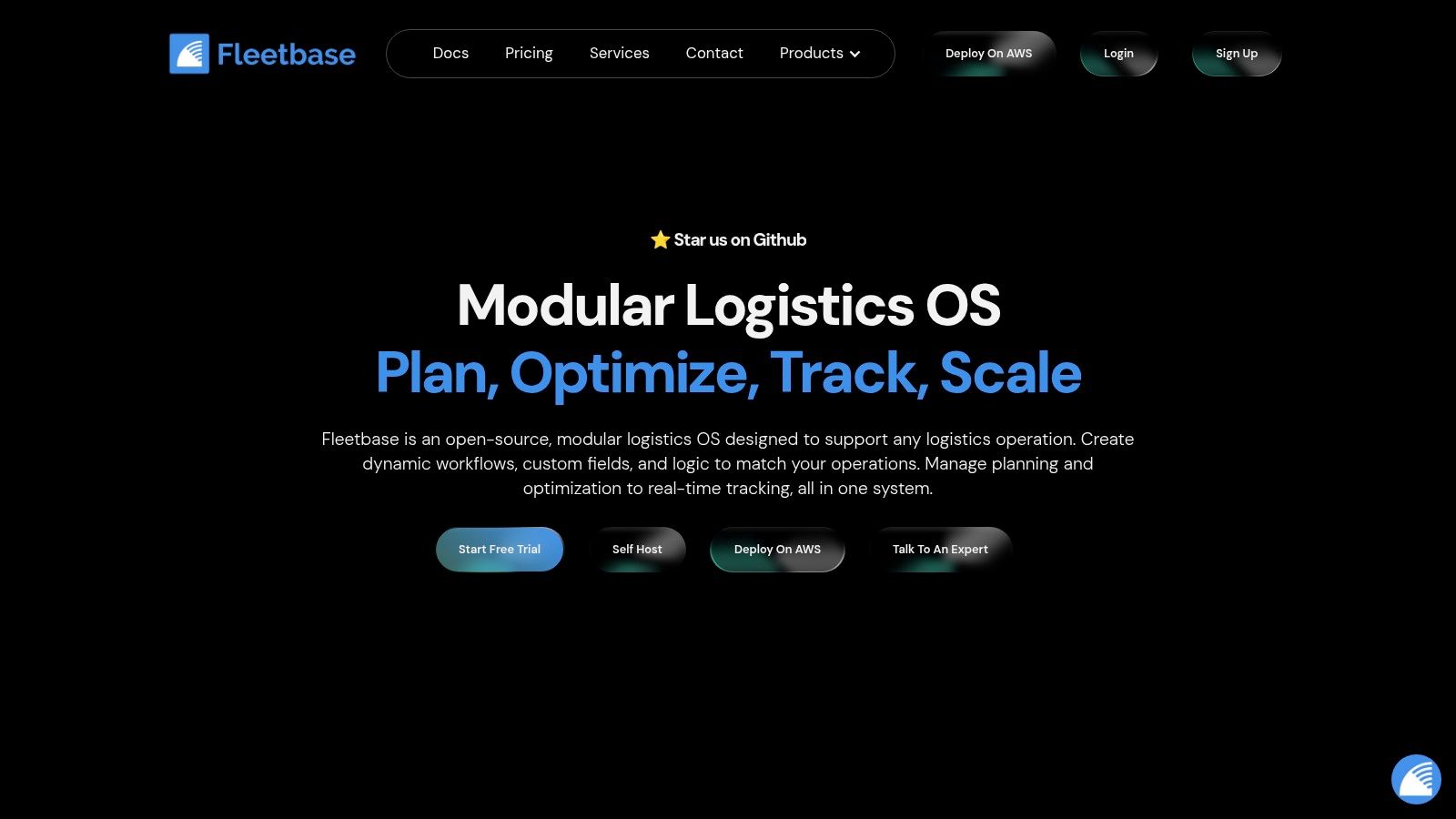
The platform’s core is open-source and can be self-hosted anywhere, completely avoiding vendor lock-in. For businesses managing sensitive data or operating in regulated industries, this is a significant advantage. The architecture includes a web console, REST/WebSocket APIs, and an Extension Marketplace, enabling teams to add functionalities like route optimization or proof of delivery without building them from scratch.
Key Features and Use Cases
- Developer-Centric: Provides extensive tooling, including SDKs and a CLI, making it a favorite for teams with engineering resources. Practical example: A last-mile delivery startup can use Fleetbase's SDK to build a custom driver app that includes company-specific checklists and branding.
- Real-Time Tracking: Offers live driver tracking and dispatch management through its console and APIs.
- Modular Extensions: The marketplace allows you to bolt on new capabilities as your business grows, keeping initial costs low.
- Self-Hosting Control: Full data ownership and the ability to deploy on your own infrastructure provide maximum security and control. For a different approach focused on emergency services, you can explore the applications offered by Resgrid.
Actionable Insight: Start with the free, self-hosted open-source core to validate your business model. As you scale, selectively purchase extensions from the marketplace instead of paying for a full-suite proprietary TMS, significantly reducing your initial and ongoing software costs. This modular approach saves money by ensuring you only pay for the exact features you need.
3. Resgrid
Resgrid is a dedicated, full-featured Computer-Aided Dispatch (CAD) platform specifically engineered for public safety and emergency response. It stands out as a powerful dispatch software open source solution for first responders, including fire departments, EMS, and law enforcement. The platform offers a complete system for managing calls, dispatching personnel and units, and tracking resources in real-time, making it an ideal, self-hostable alternative to expensive proprietary CAD systems.
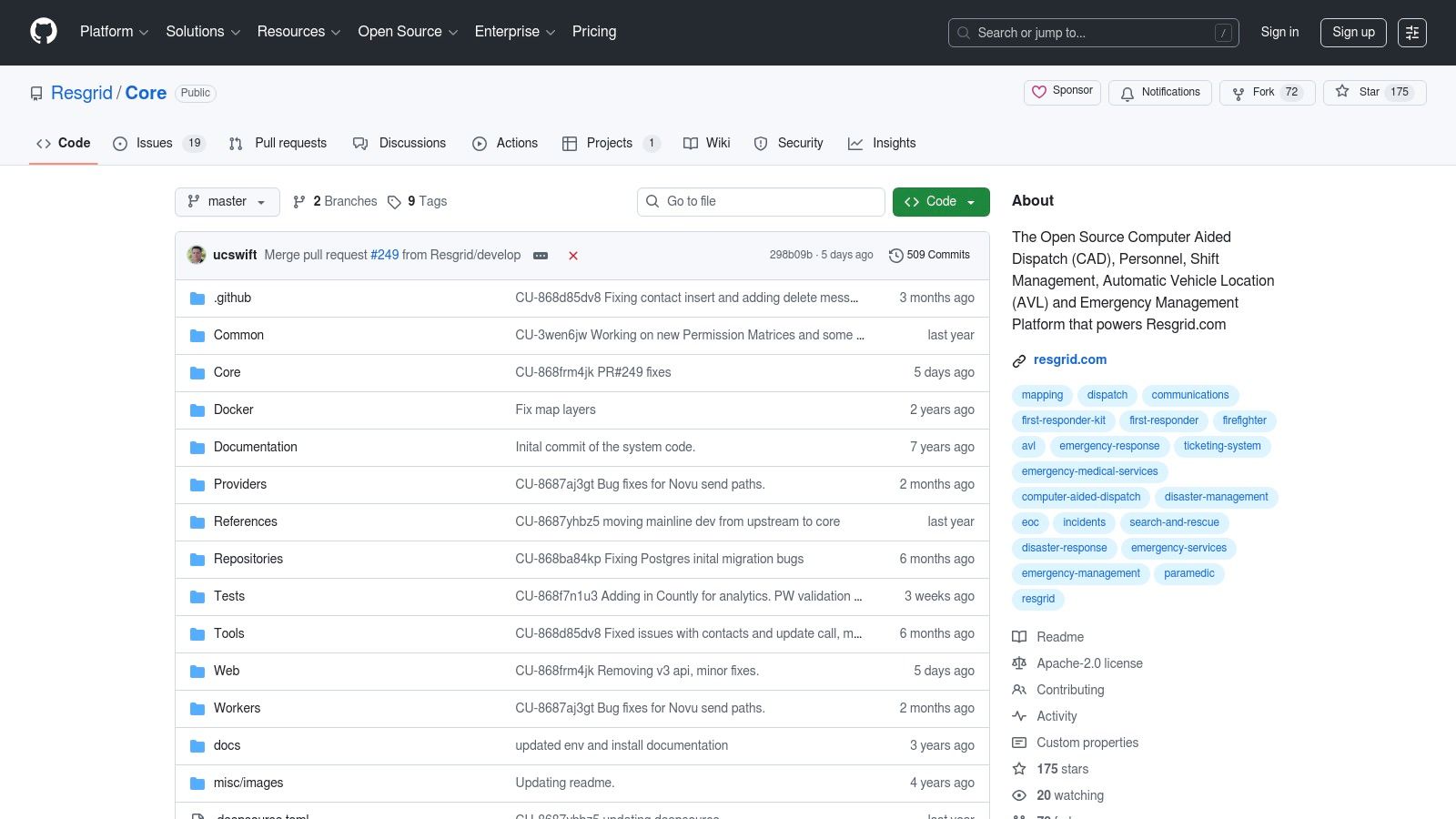
With its Apache-2.0 licensed core, organizations can deploy Resgrid on their own infrastructure, ensuring complete control over sensitive incident data. The system is built on a Windows/.NET stack with SQL Server, which is well-suited for IT environments already familiar with Microsoft technologies. Its robust architecture supports everything from incident creation and unit status tracking via its "BigBoard" dashboard to native iOS and Android apps that keep responders connected in the field.
Key Features and Use Cases
- Public Safety CAD: Purpose-built for emergency services with features for call-taking, unit dispatching, and personnel management.
- Mobile Responder Apps: Native applications for iOS and Android provide responders with critical information, navigation, and status updates. Practical example: A paramedic in the field can use the app to mark themselves "On Scene," instantly updating the central dispatch dashboard without tying up radio channels.
- Real-Time Dashboards: The BigBoard offers dispatchers a live overview of unit status, active calls, and personnel availability.
- Self-Hosted or Cloud: Provides the flexibility to self-host the open-source version or use their managed cloud service. You can see a full list of what Resgrid offers on their website.
Actionable Insight: Volunteer fire departments or small public safety agencies can dramatically reduce operational costs by deploying the open-source version of Resgrid on existing hardware. This avoids the high licensing fees of commercial CAD systems. Start with the self-hosted core and only consider the paid hosted plans if you need advanced features like SMS/text and voice call-outs, ensuring you only pay for what is essential.
4. Sahana EDEN / SAFIRE
Sahana EDEN is a powerful open-source disaster management platform, with its SAFIRE blueprint specifically tailored for emergency response coordination. It stands out by offering a comprehensive suite for the entire emergency operations lifecycle, making it far more than just a dispatch tool. This makes it an ideal dispatch software open source solution for government agencies, NGOs, and large-scale humanitarian organizations that need to manage complex incidents, from initial reporting to resource deployment and logistics.
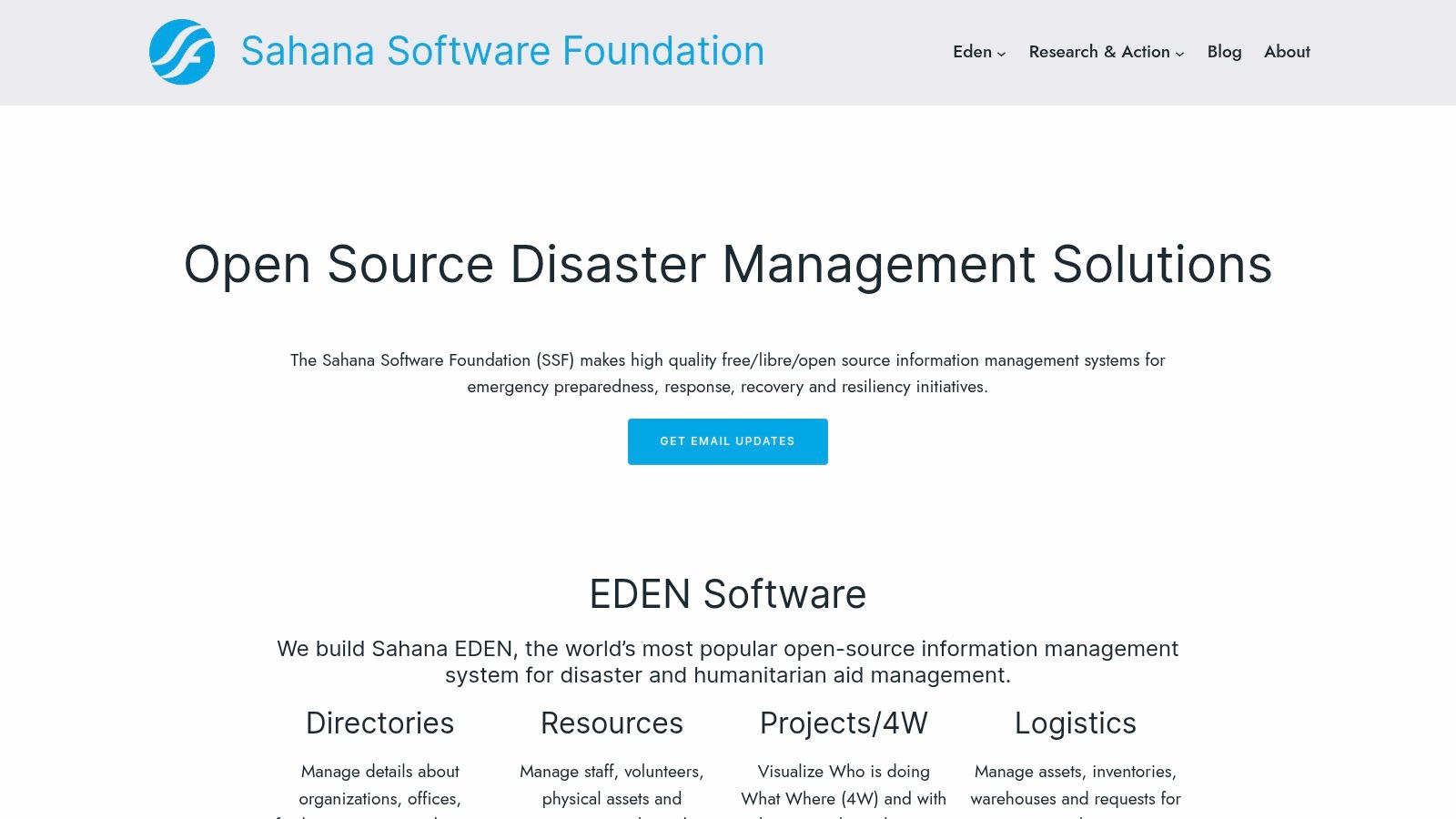
The platform is designed for mission-critical reliability and has been field-proven in major global crises. Its modular architecture allows organizations to configure the system precisely for their needs, whether it's managing incident reports from the public, dispatching first responders based on skills and availability, or tracking vital assets and inventory in warehouses. Because it is backed by the Sahana Software Foundation, a US-based nonprofit, it benefits from strong community support and adherence to international data standards.
Key Features and Use Cases
- Comprehensive Incident Management: Manages the full lifecycle, from call-center style intake to dispatching teams and resources.
- Resource and Roster Management: Effectively tracks personnel, their skills, and their availability for deployment. Practical example: During a flood response, a coordinator can use Sahana to quickly identify and dispatch volunteers who have certified swift-water rescue skills.
- Integrated Logistics: Includes modules for managing assets, inventory, and warehouse operations crucial for large-scale responses.
- Interoperability: Supports standard data formats like EDXL, ensuring seamless communication with other emergency systems.
Actionable Insight: Volunteer-based organizations can leverage the free, self-hosted version of Sahana EDEN to build a professional-grade command-and-control system without any software licensing fees. By investing in volunteer training for configuration and maintenance instead of expensive proprietary software, you can allocate your entire budget toward essential equipment and operational costs.
5. Traccar
Traccar is a highly versatile and mature open-source GPS tracking server that provides a powerful foundation for real-time fleet visibility. While not a dedicated dispatch system out-of-the-box, its robust location tracking, geofencing, and alerting capabilities make it an excellent component for building a custom dispatch software open source solution. It excels at the "where are they now?" part of logistics, allowing businesses to monitor vehicle locations, speeds, and statuses with impressive accuracy and device compatibility.
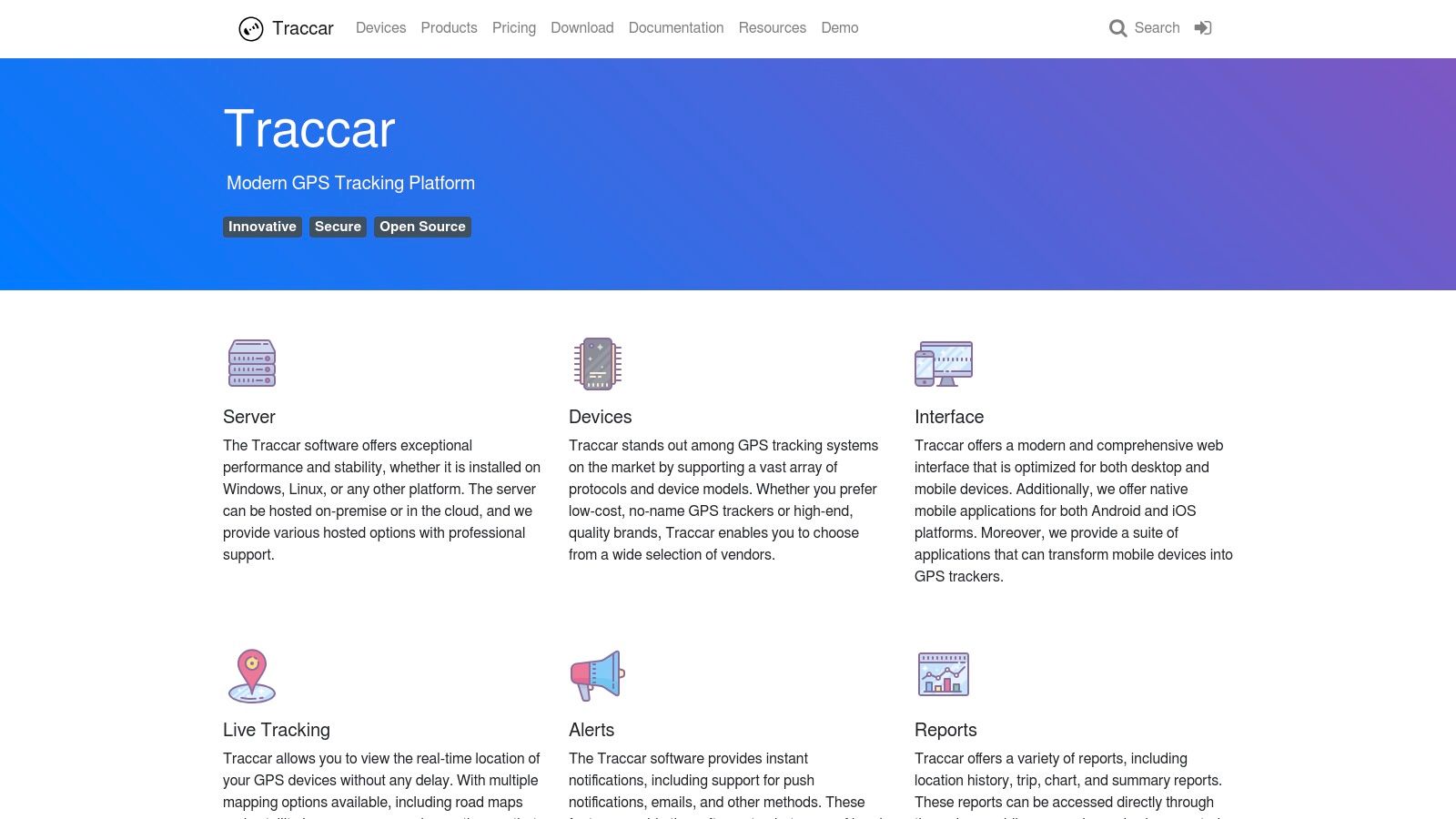
With support for over 2,000 different GPS device models and dedicated client apps for iOS and Android, Traccar offers unparalleled flexibility in hardware choice. Businesses can choose between self-hosting the platform for complete data control or opting for a managed cloud service for easier setup. This makes it an ideal choice for organizations that need a reliable, scalable tracking backbone to integrate with their existing job management or ERP systems via its well-documented API.
Key Features and Use Cases
- Massive Device Compatibility: Connect almost any GPS tracker, from dedicated vehicle hardware to simple smartphones, eliminating vendor lock-in for hardware.
- Core Tracking Functionality: Provides essential features like live tracking, trip history, geofencing, and event-based notifications (e.g., speeding, entering a zone). Practical example: A plumbing company can set up geofences around job sites and receive automatic alerts when a technician arrives and leaves, automating time-on-site logging for accurate billing.
- Flexible Deployment: Offers a free self-hosted version for maximum control and paid, managed cloud plans for convenience and support.
- API for Integration: Use its API to pull location data into other systems, enabling custom workflows like assigning the nearest driver to a new job. For a more complete out-of-the-box solution, you can explore the features offered by Open-Source Routing Machine (OSRM).
Actionable Insight: Save significant money by using Traccar as your tracking engine and pairing it with low-cost or free tools. For instance, have drivers use the free Traccar Client app on their personal smartphones instead of buying expensive dedicated GPS hardware. You can then use the API to feed this live location data into a shared spreadsheet or a simple internal dashboard for a no-cost, basic dispatch overview.
6. OpenGTS
OpenGTS stands as one of the original web-based GPS fleet tracking systems, providing a highly flexible, albeit dated, foundation for businesses with strong development capabilities. Its core strength lies in its device-agnostic tracking infrastructure, built on a robust Java and MySQL stack. While not a ready-made dispatch solution out of the box, it offers the essential real-time location data and reporting tools necessary to build a custom dispatch software open source platform tailored to specific operational workflows.
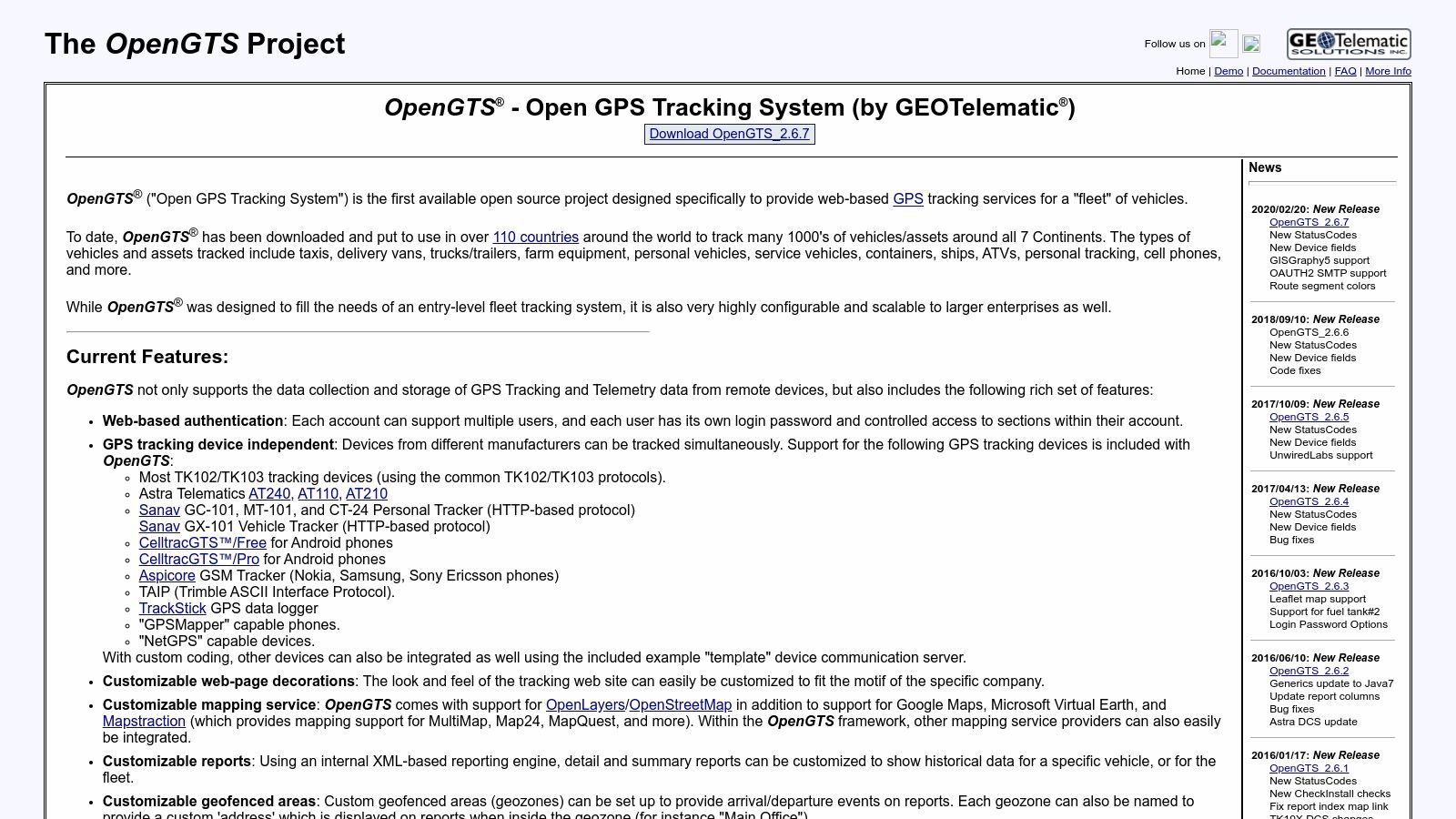
The platform’s longevity means it has extensive documentation and a stable, time-tested codebase. Licensed under the Apache 2.0 license, it allows for commercial use and modification without fees. This makes it an excellent choice for companies that need a self-hosted tracking backend and are willing to invest engineering resources to build the user-facing dispatch and job assignment functionalities on top of it.
Key Features and Use Cases
- DIY Fleet Tracking: Ideal for businesses that need a foundational, self-hosted GPS tracking engine to integrate into larger, custom-built applications.
- Device Agnostic: Supports a wide range of GPS tracking devices, giving you the freedom to choose hardware based on cost and features. Practical example: A logistics company can source affordable GPS trackers directly from a manufacturer and configure them to report to their self-hosted OpenGTS instance, avoiding marked-up hardware costs from service providers.
- Extensive Customization: Provides tools for creating custom reports, maps, and event rules, allowing deep adaptation to unique business logic.
- Commercial-Friendly License: The Apache 2.0 license allows you to build and even sell a commercial product based on the OpenGTS core. Explore other platforms with strong communities like Open Source Routing Machine (OSRM) for advanced routing capabilities.
Actionable Insight: Leverage OpenGTS as a free, stable backend for GPS data collection to avoid paying per-device subscription fees common with proprietary tracking services. Hire a freelance developer to build a simple dispatch interface that pulls location data from your self-hosted OpenGTS instance. This one-time development cost can be significantly cheaper long-term than recurring SaaS fees, especially as your fleet size grows.
7. LibreTaxi
LibreTaxi offers a radically different approach to dispatch, functioning as an open-source, Telegram-based ride-hailing alternative to giants like Uber and Lyft. It’s designed for simplicity and community control, allowing passengers and drivers to negotiate terms directly. This model makes it a unique dispatch software open source solution, perfect for localized networks such as university campuses, small towns, or community transport cooperatives where trust is high and formal infrastructure is minimal.
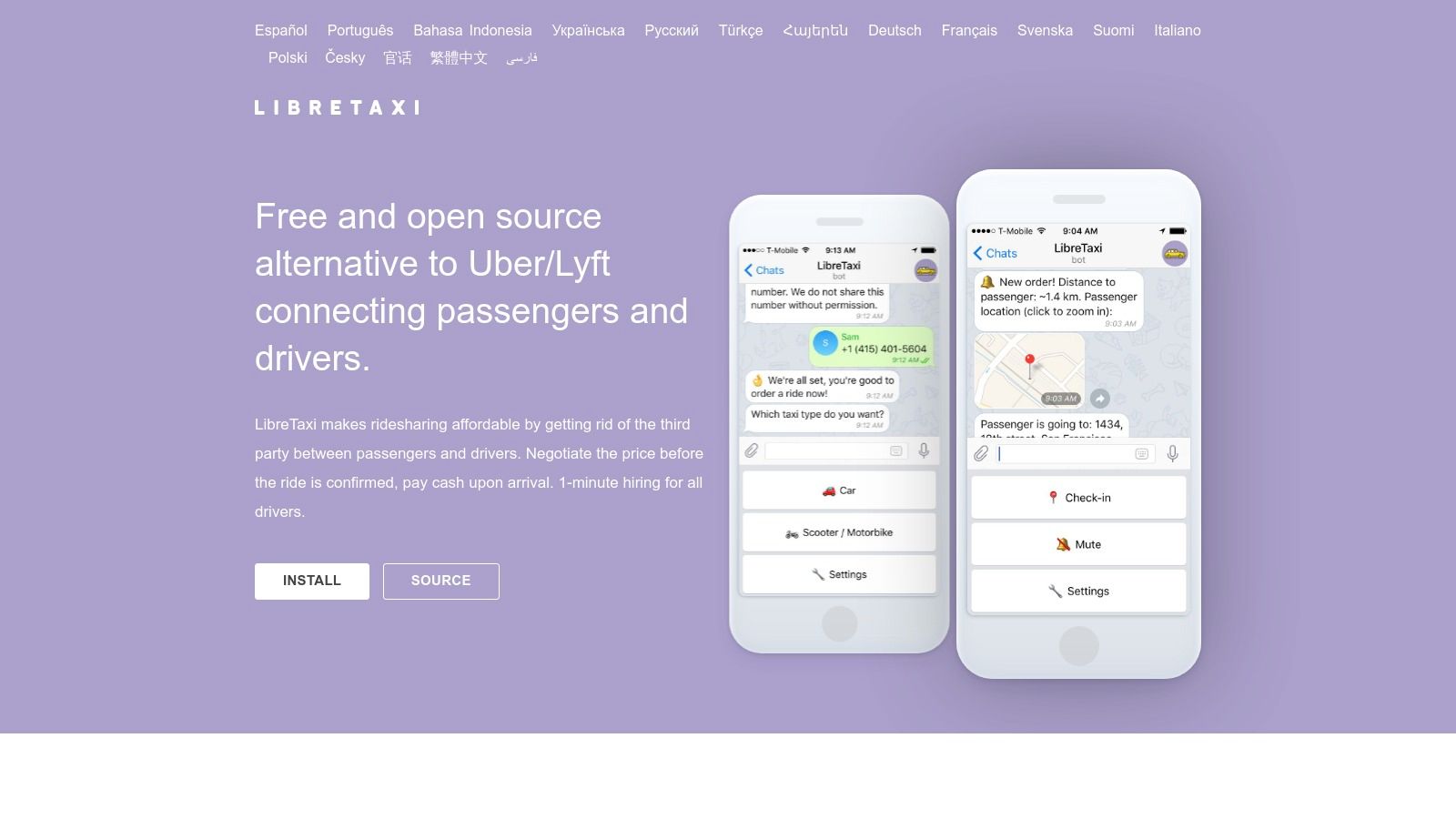
Running on Node.js and licensed under AGPLv3, the platform is entirely self-hosted, giving operators full control over their deployment and data without vendor fees. Its primary strength lies in its adaptability; because it bypasses complex payment gateways and rigid pricing, it can be quickly deployed in areas with diverse local regulations or where cash transactions are preferred. The direct negotiation workflow empowers both drivers and riders, fostering a more transparent, community-oriented service model.
Key Features and Use Cases
- Telegram-Based Operation: Leverages a ubiquitous messaging app for a user-friendly and low-barrier-to-entry interface.
- Direct Negotiation: Facilitates a direct conversation between passenger and driver for fare agreement, eliminating fixed commission structures. Practical example: In a small rural town, a driver can use LibreTaxi to offer a flat rate for a common trip to the grocery store, negotiating directly with a regular customer via Telegram.
- Community-Focused: Ideal for creating private or semi-private ride-sharing networks for specific communities, events, or organizations.
- Simple Deployment: Built on a straightforward Node.js infrastructure, making it easy for those with basic technical skills to set up and manage.
Actionable Insight: Avoid credit card processing fees entirely by launching a cash-first ride-sharing or local delivery service. Deploy LibreTaxi on a low-cost server to create a community-run network for a specific neighborhood or event. This eliminates the 2-3% transaction fees charged by payment processors, allowing you to pass the savings directly to drivers and customers or to fund the service's operational costs.
8. Ontaxi “taxiserver”
Ontaxi’s “taxiserver” is a GPL-licensed, purpose-built dispatch server designed specifically for taxi and ride-hailing services. As a completely free and transparent dispatch software open source solution, it provides a functional backend with dispatcher web panels and a defined driver communication protocol. Its reliance on open map services like OpenStreetMap, Nominatim, and OSRM makes it an excellent choice for operators in regions poorly covered by commercial map providers or for those wanting to avoid expensive API fees.
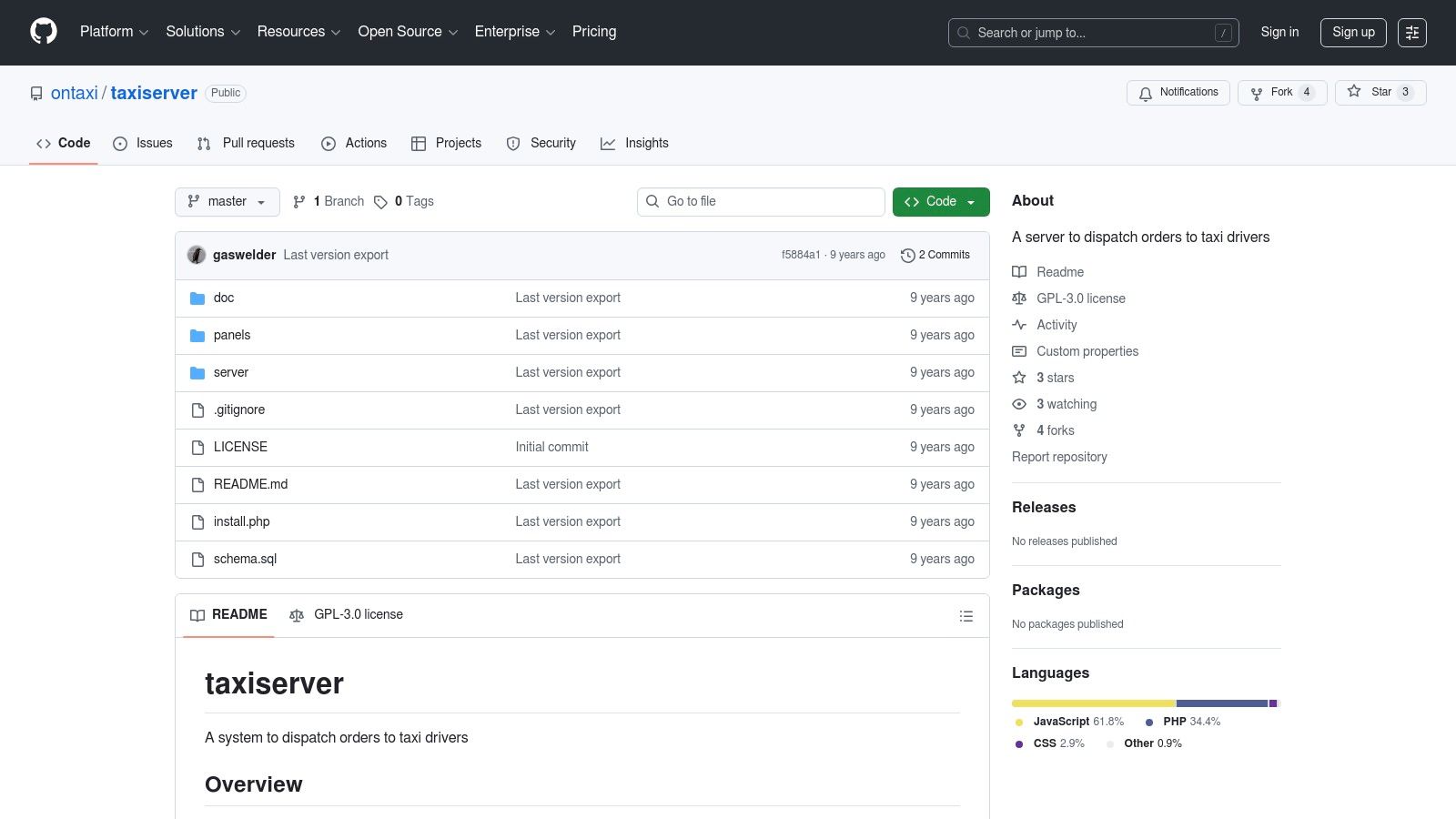
The platform is built on a straightforward PHP and MySQL/MariaDB stack, simplifying self-hosting for those with basic web server management skills. While the technology stack is somewhat dated (PHP5), its simplicity allows for easier modification and adaptation. This project is ideal for small to medium-sized taxi companies needing a core dispatch system they can fully control and customize without any initial software investment.
Key Features and Use Cases
- Taxi-Centric Design: Includes core functionalities for order creation, driver assignment, and status tracking tailored for taxi operations. Practical example: A small local taxi company can use the web panel to manually assign a new phone-in ride request to the closest available driver shown on the map.
- Open Map Integration: Leverages free geocoding and routing services, eliminating reliance on costly Google Maps or HERE APIs.
- Full Source Code Access: The GPL license ensures you can inspect, modify, and deploy the entire system on your own infrastructure.
- Simple Tech Stack: The PHP/MySQL foundation is widely supported by hosting providers, making deployment relatively accessible. Learn more about the project at its GitHub repository.
Actionable Insight: Avoid recurring map API costs by hosting your own Nominatim and OSRM instances. While this requires initial server setup, it can save thousands of dollars annually compared to pay-per-call commercial map services, making your operation more profitable. This is especially effective in geographically concentrated service areas where a single server can handle all routing and geocoding needs.
9. Alibaba EasyDispatch
Alibaba EasyDispatch is an open-source, real-time dispatch planning engine designed for complex field service operations. Instead of providing a ready-made user interface, it offers a powerful algorithmic core that uses heuristic, optimization, and reinforcement learning to solve challenging vehicle routing and job assignment problems. This makes it an ideal dispatch software open source foundation for tech-savvy organizations that need to build a highly customized system for assigning tasks based on worker skills, specific rules, and dynamic working hours.
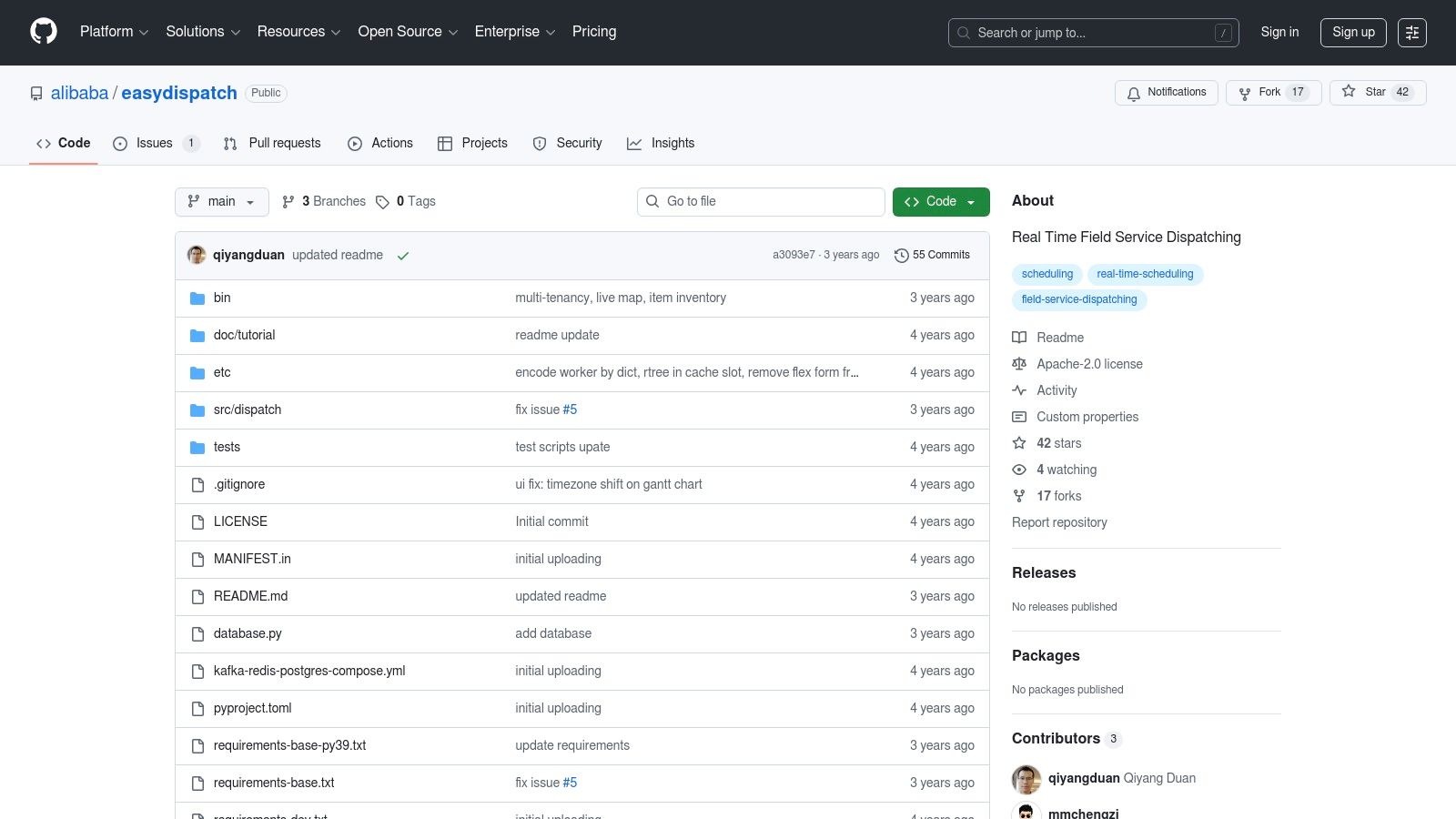
The project, available on GitHub, provides a complete backend blueprint using Docker Compose, integrating scalable technologies like Kafka, Redis, and Postgres. Its strength lies in its advanced algorithms and explainable "what-if" scenarios, which allow developers to model and understand the logic behind dispatch decisions. While it requires significant development effort to build a front-end, the Apache-2.0 license offers complete freedom for commercial use and modification.
Key Features and Use Cases
- Advanced Algorithmic Core: Leverages sophisticated algorithms for complex real-time dispatch and routing optimization. Practical example: A home appliance repair company can use the engine to automatically assign a new service call not just to the nearest technician, but to the nearest one who also has the specific certification and parts needed for that appliance model.
- Developer-Focused Blueprint: Comes with a REST API and a reference stack (Python/Node/Vue) for building a complete solution.
- Scalable Architecture: Built with modern components like Kafka and Redis to handle high-volume dispatch operations.
- Flexible Licensing: The Apache-2.0 license permits unrestricted use and modification, even for commercial products.
Actionable Insight: Avoid the immense cost and time of developing a dispatch optimization algorithm from scratch. Use EasyDispatch as your backend engine and focus your development budget on creating a user interface tailored to your specific workflow. This approach allows you to build a proprietary-level optimization system for a fraction of the R&D cost.
10. Odoo Community Association – Field Service
For businesses already invested in the Odoo ecosystem, the Odoo Community Association (OCA) provides a powerful suite of modules for field service management. Rather than a standalone product, this is an extension for the Odoo Community ERP, transforming it into a fully capable dispatch software open source solution. It's ideal for service-based SMBs that need dispatching tightly integrated with their existing CRM, invoicing, and inventory management, creating a seamless end-to-end operational workflow.
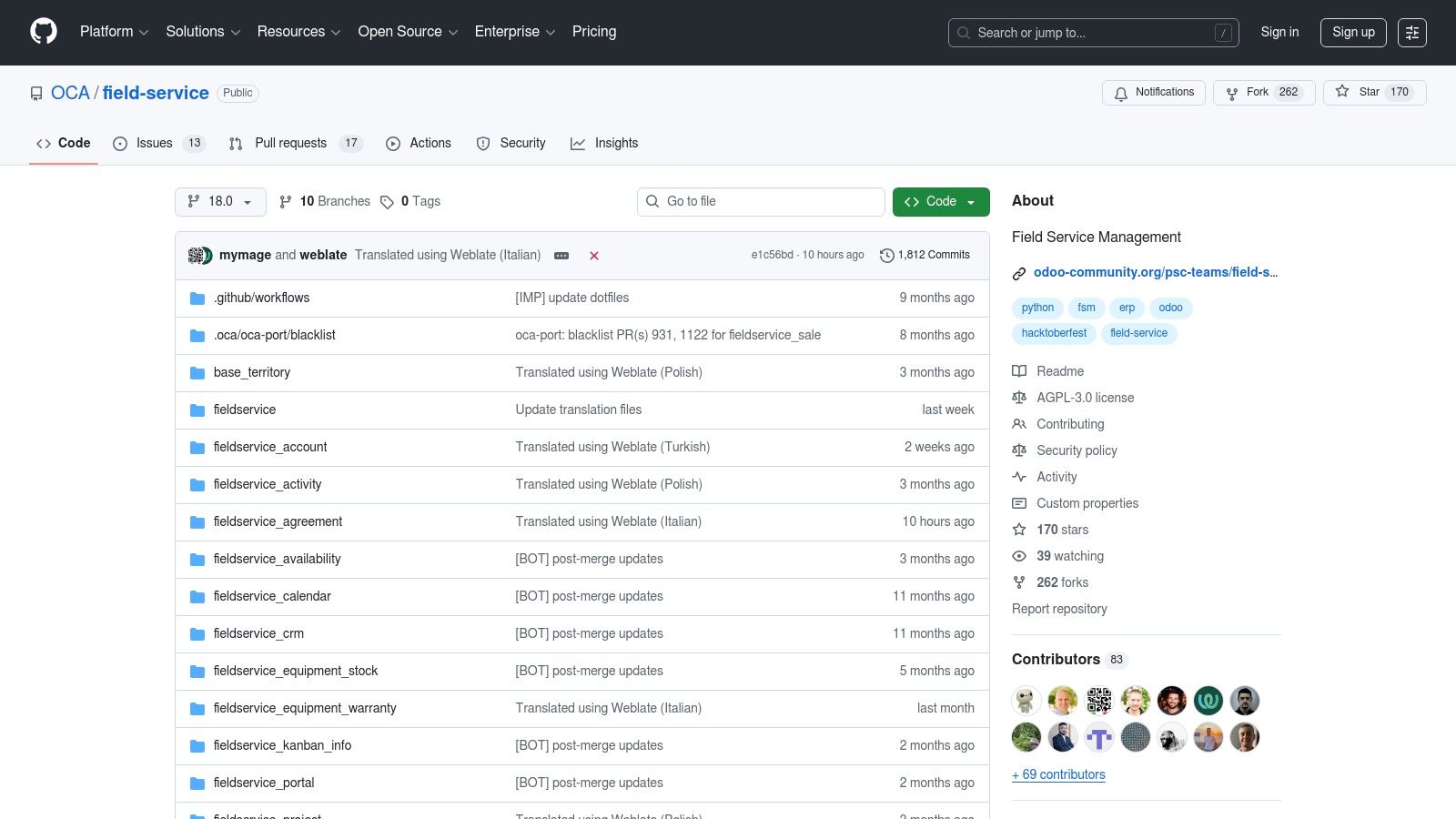
This modular approach allows companies to deploy only the specific functionalities they need, such as technician scheduling, service order creation, and basic routing. Since it's built on the Odoo framework and released under an AGPL license, it benefits from a vast community and numerous integrators, making customization and support accessible. However, it does require a functional Odoo Community instance to operate, which may involve a learning curve for newcomers.
Key Features and Use Cases
- Deep ERP Integration: Directly connects dispatch tasks to customer records, sales orders, and accounting, eliminating data silos.
- Modular Deployment: Install only the necessary field service modules to keep the system lightweight and avoid unnecessary complexity.
- Community-Driven: Backed by the active OCA, ensuring ongoing development, bug fixes, and a strong support network.
- End-to-End Workflow: Manage the entire service lifecycle, from creating a work order in the CRM to invoicing the customer after job completion. Practical example: An HVAC company can create a service task in Odoo, assign it to a technician, track their time and parts used on the job, and automatically generate an invoice from the same system once the work is complete. You can find the modules and documentation on their GitHub repository.
Actionable Insight: If your service company is evaluating ERPs, consider starting with the free Odoo Community Edition and adding the OCA Field Service modules. This strategy gives you a powerful, integrated dispatch and business management suite for zero licensing fees, saving you thousands compared to proprietary solutions like Salesforce Field Service or ServiceMax. Your primary cost will be implementation and hosting, which you control.
11. Tickets CAD (Open ISES Project)
Tickets CAD, maintained under the Open ISES Project, is a long-standing, web-based Computer-Aided Dispatch (CAD) system designed for simplicity and accessibility. It's an excellent choice for volunteer organizations, smaller emergency service agencies, and event management teams that need a functional, no-frills dispatch software open source solution. Its core strength lies in providing essential dispatch capabilities like incident management and unit tracking without the complexity or cost of enterprise-grade systems.
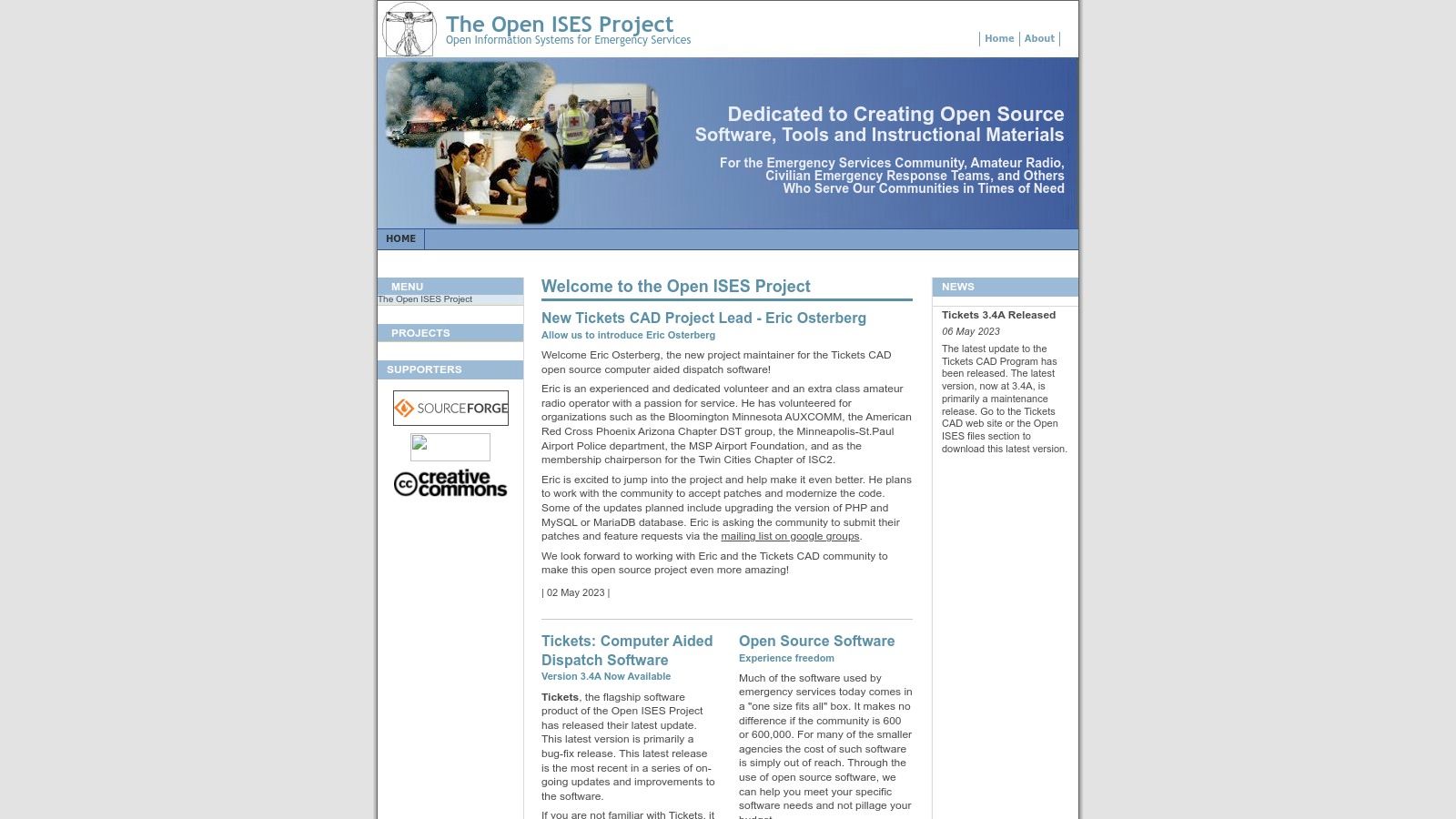
The platform is built on a straightforward PHP and MySQL stack, making it relatively easy to deploy and maintain for teams with basic web development skills. It integrates Google Maps for unit and incident visualization and supports notifications via email and SMS, ensuring key personnel stay informed. The active user community provides a valuable support network for troubleshooting and sharing best practices, which is crucial for organizations without dedicated IT staff.
Key Features and Use Cases
- Volunteer-Friendly: The browser-based UI is designed to be intuitive for users who may not have professional dispatch training.
- Core CAD Functionality: Includes incident boards, unit status tracking, and dispatch logging essential for coordinated responses. Practical example: A community watch group can use Tickets CAD during a local festival to log minor incidents, dispatch volunteer patrols, and track their locations on a central map.
- Integrated Mapping: Utilizes Google Maps and APRS for real-time visualization of unit locations and incident sites.
- Community-Driven Support: A strong community forum offers peer support, a key advantage for resource-constrained teams. For a more modern API-first alternative, you might also consider Fleetbase.
Actionable Insight: For a community event or a volunteer fire department, deploy Tickets CAD on a low-cost shared hosting plan. Its minimal system requirements mean you can run a fully functional CAD system for just a few dollars a month, avoiding the high licensing fees of commercial software. This makes it an ideal, budget-friendly choice for proving operational concepts or managing small-scale operations.
12. Netflix Dispatch
Netflix Dispatch offers a unique take on a dispatch software open source solution by focusing exclusively on IT and security incident management, not vehicle or personnel logistics. Developed and battle-tested by Netflix, this platform is engineered to orchestrate people, tasks, and communications during a crisis. It excels at automating incident response workflows, ensuring that the right people are engaged at the right time with the right information, which is critical for minimizing downtime and resolving security threats efficiently.
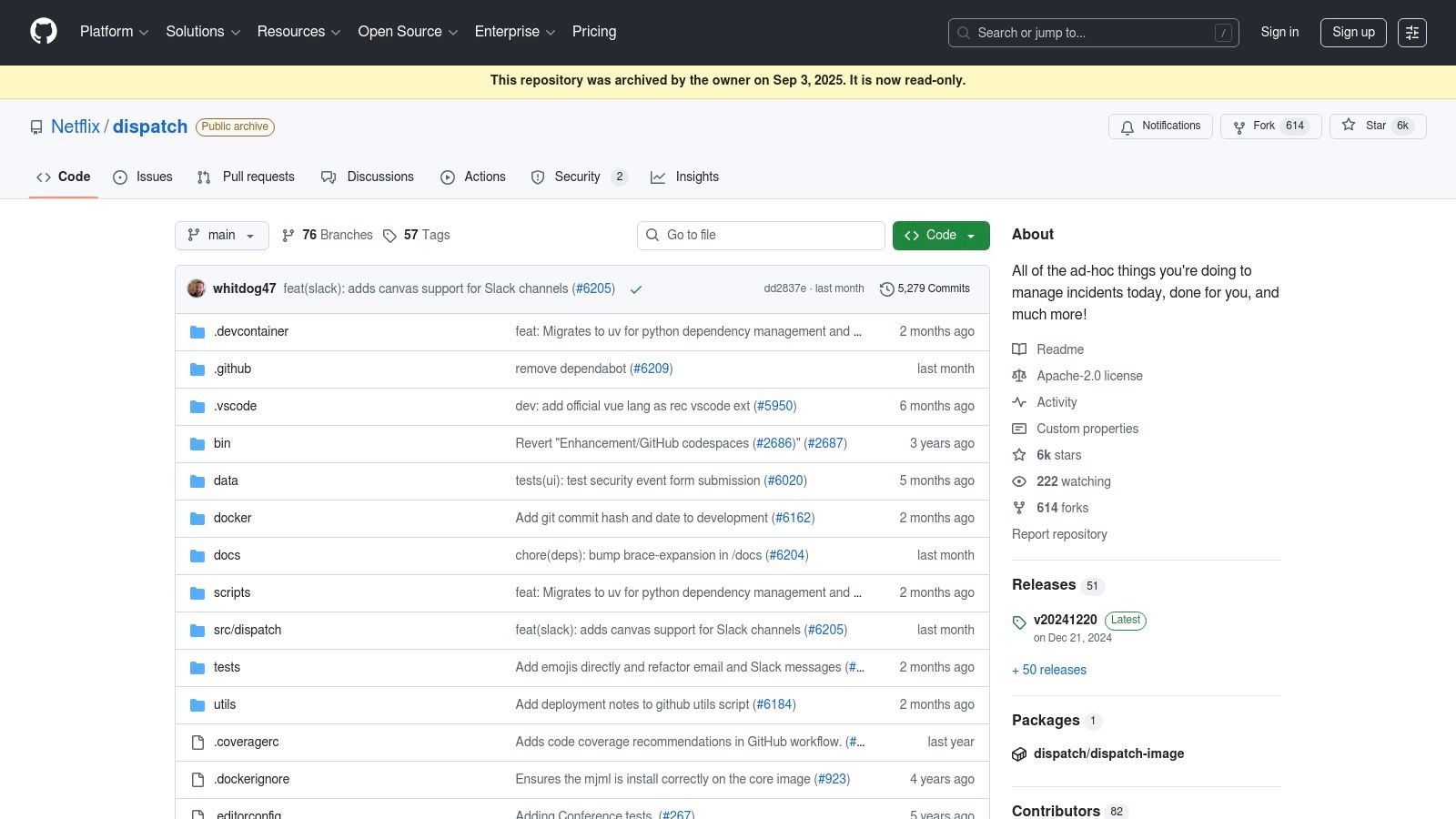
The platform’s power lies in its deep integration capabilities with essential enterprise tools like Slack for communication, Jira for ticketing, and Google Suite for documentation. This creates a centralized command center for incident response, from initial alert to post-mortem analysis. While the official repository is now archived, its robust architecture and strong documentation make it an excellent foundation for development teams willing to fork and maintain their own version, tailoring it to specific organizational needs.
Key Features and Use Cases
- Incident Response Orchestration: Automates creating incident channels, assigning roles (e.g., Incident Commander), and paging on-call personnel. Practical example: When a critical server monitoring system triggers an alert, Dispatch can automatically create a dedicated Slack channel, invite the on-call SRE team, page the Incident Commander, and create a Jira ticket to track the issue.
- Seamless Integrations: Natively connects with Slack, Jira, PagerDuty, and Google Docs to streamline workflows without context switching.
- Extensible Framework: Built with Python, it is highly customizable, allowing teams to add new plugins for different alerts or tools.
- Proven Reliability: Developed and used internally at Netflix, providing a resilient and well-documented codebase. For more logistics-focused route planning, consider exploring the tools offered by Open Source Routing Machine.
Actionable Insight: Since the official repository is archived, you can fork the project on GitHub at zero cost. By self-hosting and maintaining your own instance, you avoid expensive licensing fees for proprietary incident management platforms like PagerDuty or Opsgenie. Your internal development team can then customize the integrations and workflows, creating a bespoke solution that perfectly fits your tech stack without any recurring subscription costs.
Open Source Dispatch Software Comparison
| Product | Core Features / Functionality | User Experience / Quality ★ | Value Proposition 💰 | Target Audience 👥 | Unique Selling Points ✨ |
|---|---|---|---|---|---|
| Resgrid, LLC 🏆 | All-in-one dispatch, messaging, personnel & equipment tracking | ★★★★☆ Mature, user-friendly UI | 💰 No contracts, self-service, free updates | 👥 First responders, public safety, businesses | ✨ Open-source, customizable, real-time chat & tracking |
| Fleetbase | Open-source logistics platform with APIs & marketplace | ★★★★ Developer-centric | 💰 Self-host or managed options | 👥 Delivery startups, logistics teams | ✨ Modular architecture, strong dev tools |
| Resgrid | Open-source CAD with mobile apps & unit management | ★★★★ Mature, mobile-focused | 💰 Free open-source + paid hosted tiers | 👥 Emergency services departments | ✨ Native apps, BigBoard dashboards |
| Sahana EDEN / SAFIRE | Disaster mgmt suite with incident intake & resource dispatch | ★★★★ Enterprise-grade workflows | 💰 Free, non-profit supported | 👥 Governments, NGOs, large agencies | ✨ Broad emergency ops beyond dispatch |
| Traccar | GPS tracking server with geofencing & alerts | ★★★★ Broad device support | 💰 Free self-host or paid cloud | 👥 Fleet managers, tracking users | ✨ Supports 2000+ devices, commercial support |
| OpenGTS | Early GPS fleet tracking with customizable reports | ★★★★ Time-tested but older UX | 💰 Free, Apache licensed | 👥 DIY fleet operators, developers | ✨ Highly customizable, documented |
| LibreTaxi | Telegram-based ride-hailing & dispatch alternative | ★★★☆☆ Simple, community driven | 💰 No vendor fees | 👥 Community ride services | ✨ Cash payments, multi-language support |
| Ontaxi “taxiserver” | Taxi dispatch server with open map integration | ★★★☆☆ Purpose-built but dated tech | 💰 Free, GPL licensed | 👥 Taxi companies | ✨ OpenStreetMap integration |
| Alibaba EasyDispatch | Real-time dispatch planner with advanced optimization | ★★★★ Strong algorithmic foundation | 💰 Free, Apache licensed | 👥 Large scale field services | ✨ AI-driven routing & decision support |
| Odoo Community – Field Service | Field service scheduling modules with CRM/invoicing | ★★★★ Modular and integrable | 💰 Free, AGPL licensed | 👥 SMB service companies | ✨ ERP integration, modular deployment |
| Tickets CAD (Open ISES) | Web CAD with mapping, unit tracking & notifications | ★★★☆☆ Community-driven, older UI | 💰 Free, open-source | 👥 Small emergency agencies, volunteers | ✨ Volunteer-friendly workflows |
| Netflix Dispatch | IT/security incident response orchestration | ★★★★ Enterprise-level automation | 💰 Free, open source | 👥 IT/security teams | ✨ Slack/Jira integration, incident workflows |
Making the Right Choice for Your Operations
The journey through the world of dispatch software open source reveals a diverse and powerful landscape of tools. From comprehensive, ready-to-deploy platforms like Resgrid and Sahana EDEN to modular, developer-focused frameworks like Fleetbase and Traccar, there is a solution tailored to nearly any operational need. The common thread connecting them all is the unparalleled control and flexibility they offer, freeing organizations from vendor lock-in and expensive licensing fees.
The most significant takeaway is that the "best" tool is entirely dependent on your specific context. A volunteer fire department gains immense value from a purpose-built CAD like Resgrid, while a growing logistics company will find the scalability of a solution like Fleetbase or Odoo's Field Service module to be a strategic asset. The choice you make today will define your operational agility and budget for years to come.
Key Factors for Your Final Decision
Before committing to a platform, carefully assess these critical areas to ensure a successful implementation:
- Technical Expertise: Be honest about your team's capabilities. A self-hosted solution like OpenGTS or Traccar offers the greatest cost savings by eliminating monthly subscription fees, but it requires a solid understanding of server management, security, and maintenance. If your team lacks these skills, the hidden costs of hiring a consultant or the risks of a poorly secured system could outweigh the benefits.
- Community and Support: An active community is your lifeline. A project with a bustling forum, frequent code commits, and detailed documentation (like Traccar or Sahana) is a much safer bet than one with a dormant repository. This community support is your free, ongoing technical assistance.
- Core Feature Alignment: Don't be swayed by a long list of features you'll never use. Focus on your non-negotiable requirements. If real-time GPS tracking is paramount, Traccar and OpenGTS are top contenders. If comprehensive incident management and personnel tracking are critical, Resgrid or Tickets CAD are more appropriate.
- Scalability and Future Needs: Consider where your organization will be in three to five years. A lightweight tool like LibreTaxi might be perfect for a small startup, but will it handle a hundred drivers and thousands of daily calls? Choosing a platform with a modular architecture allows you to scale your system as your operations grow.
Actionable Next Steps to Take
Armed with this information, your path forward is clear. Start by creating a detailed checklist of your must-have features, technical resources, and budget constraints. Shortlist two or three options from this article that most closely match your profile.
For those who need a more direct comparison with commercial systems, or are still weighing the pros and cons between open-source and proprietary software, exploring a detailed guide can provide additional clarity. For those seeking comprehensive reviews of various platforms, exploring resources like a guide to the best emergency dispatch software options can help you make a fully informed decision.
Ultimately, embracing dispatch software open source is an empowering move. It places the power to innovate, adapt, and control your essential operations firmly in your hands, providing a sustainable and cost-effective foundation for future success.
If you're looking for a powerful, open-source dispatch and communications platform designed specifically for first responders and field service organizations, consider Resgrid, LLC. Resgrid, LLC offers both a self-hosted open-source version and a managed SaaS solution, providing the flexibility to choose the deployment model that best fits your technical capabilities and budget.

